Related Research Articles

The Cree are a North American Indigenous people. They live primarily in Canada, where they form one of the country's largest First Nations. More than 350,000 Canadians are Cree or have Cree ancestry. The major proportion of Cree in Canada live north and west of Lake Superior, in Ontario, Manitoba, Saskatchewan, Alberta, and the Northwest Territories. About 27,000 live in Quebec.

The Piegan are an Algonquian-speaking people from the North American Great Plains. They are the largest of three Blackfoot-speaking groups that make up the Blackfoot Confederacy; the Siksika and Kainai are the others. The Piegan dominated much of the northern Great Plains during the nineteenth century.

The Blackfoot Confederacy, Niitsitapi, or Siksikaitsitapi, is a historic collective name for linguistically related groups that make up the Blackfoot or Blackfeet people: the Siksika ("Blackfoot"), the Kainai or Blood, and two sections of the Peigan or Piikani – the Northern Piikani (Aapátohsipikáni) and the Southern Piikani. Broader definitions include groups such as the Tsúùtínà (Sarcee) and A'aninin who spoke quite different languages but allied with or joined the Blackfoot Confederacy.

The Kainai Nation is a First Nations band government in southern Alberta, Canada, with a population of 12,800 members in 2015, up from 11,791 in December 2013.
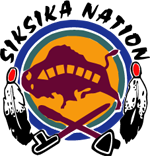
The Siksika Nation is a First Nation in southern Alberta, Canada. The name Siksiká comes from the Blackfoot words sik (black) and iká (foot), with a connector s between the two words. The plural form of Siksiká is Siksikáwa. The Siksikáwa are the northernmost of the Niitsítapi, all of whom speak dialects of Blackfoot, an Algonquian language.

The Piikani Nation is a First Nation, representing the Indigenous people in Canada known as the Northern Piikani or simply the Peigan.
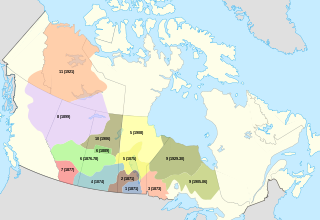
Treaty 7 is an agreement between the Crown and several, mainly Blackfoot, First Nation band governments in what is today the southern portion of Alberta. The idea of developing treaties for Blackfoot lands was brought to Blackfoot chief Crowfoot by John McDougall in 1875. It was concluded on September 22 and December 4, 1877. The agreement was signed at the Blackfoot Crossing of the Bow River, at the present-day Siksika Nation reserve, approximately 75 km (47 mi) east of Calgary. Chief Crowfoot was one of the signatories to Treaty 7. Another signing on this treaty occurred on December 4, 1877, to accommodate some Blackfoot leaders who were not present at the primary September 1877 signing.
First Nations in Alberta are a group of people who live in the Canadian province of Alberta. The First Nations are peoples recognized as Indigenous peoples or Plains Indians in Canada excluding the Inuit and the Métis. According to the 2011 Census, a population of 116,670 Albertans self-identified as First Nations. Specifically there were 96,730 First Nations people with registered Indian Status and 19,945 First Nations people without registered Indian Status. Alberta has the third largest First Nations population among the provinces and territories. From this total population, 47.3% of the population lives on an Indian reserve and the other 52.7% live in urban centres. According to the 2011 Census, the First Nations population in Edmonton totalled at 31,780, which is the second highest for any city in Canada. The First Nations population in Calgary, in reference to the 2011 Census, totalled at 17,040. There are 48 First Nations or "bands" in Alberta, belonging to nine different ethnic groups or "tribes" based on their ancestral languages.

Stoney 142, 143, 144 is an Indian reserve of the Stoney Nakoda First Nation, comprising Bearspaw, Chiniki, and Wesley First Nations in Alberta, located between the Municipal District of Bighorn No. 8 and Rocky View County. The largest community of the Nakoda people, it is 56 kilometers west of Calgary.
The North American Indigenous Games is a multi-sport event involving indigenous North American athletes staged intermittently since 1990. The games are governed by the North American Indigenous Games Council, a 26-member council of representatives from 13 provinces and territories in Canada and 13 regions in the United States.
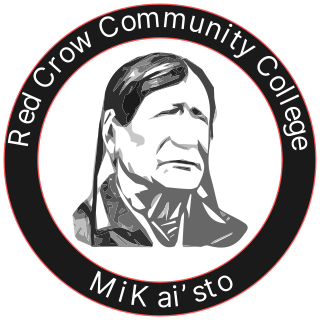
Red Crow Community College is a college located on the Kainai Nation reserve in southern Alberta, Canada with a campus in Lethbridge.

Blood 148 is a First Nations reserve in Alberta, Canada. It is inhabited by the Blood (Kainai) First Nation and was established under the provisions of Treaty 7. This reserve is managed from the community of Stand Off on its northwest border and encompasses the majority of lands bounded by the cities of Fort MacLeod, Lethbridge and Cardston. It is traversed by Alberta Highway 2, Highway 5, and Highway 509. The St Mary River and the Belly River are major rivers supplying and draining the lands.
Hugh Aylmer Dempsey, was a Canadian historian, an author and the Chief Curator Emeritus of the Glenbow Museum in Calgary, Alberta. Dempsey authored more than 20 books, focusing primarily on the history of people of the Blackfoot Confederacy. He received an honorary doctorate from the University of Calgary and was made an honorary chief of the Kainai Blackfoot in 1967. For his contributions to the study of the Plains Indians, Dempsey was awarded membership in the Order of Canada in 1975.

Stand Off is an unincorporated community in southern Alberta, Canada within the Blood (Kainai) reserve. It is on Highway 2, approximately 43 km southwest of Lethbridge and 30 km (19 mi) north of Cardston. The people living in Stand Off and on the reserve are a part of the Blackfoot Nation of Canada and the United States. The Blood Tribe (Nation) has the largest landmass in all eleven Numbered Treaties in Canada, (1871–1921).
Saddle Lake Cree Nation is a Plains Cree, First Nations community, located in the Amiskwacīwiyiniwak region of central Alberta, Canada. The Nation is a signatory to Treaty 6, and their traditional language is Plains Cree.
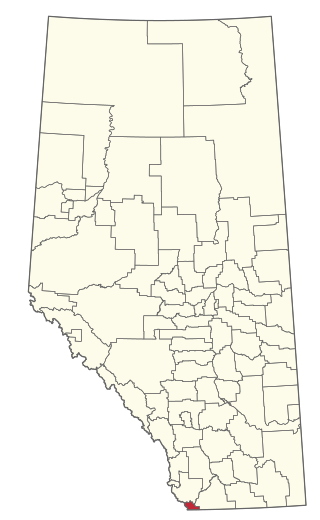
Improvement District No. 4, or Improvement District No. 04 (Waterton), is an improvement district in Alberta, Canada. Coextensive with Waterton Lakes National Park in southern Alberta, the improvement district provides local governance for lands within the park that are not within an Indian reserve.
Eugene Brave Rock is a Canadian actor and stuntman. Brave Rock started as an actor, before being trained as a stuntman; he later appeared in various minor television roles before landing his first major film role as Chief in Wonder Woman.
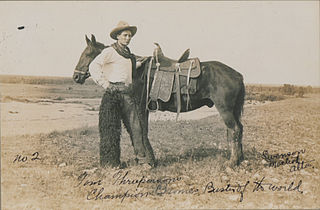
Tom Three Persons was a Niitsitapi rodeo athlete and rancher and a member of the Kainai Nation (Blood). Best known for winning the saddle bronc competition at the inaugural Calgary Stampede in 1912. An Indigenous athlete, he was the only Canadian to win a championship at this historic rodeo competition.
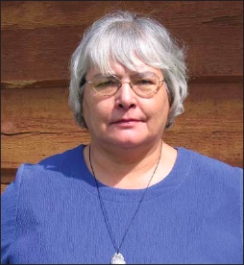
Marie Smallface Marule was a Canadian academic administrator, activist, and educator. She served as executive director of the National Indian Brotherhood (NIB), chief administrator of the World Council of Indigenous Peoples (WCIP), and secretary of the Indian Association of Alberta. Marule was president of Red Crow Community College for two decades, and led the creation of several indigenous studies programs. She was previously an assistant professor of Native American studies at the University of Lethbridge.
Joy SpearChief-Morris is an indigenous Canadian hurdler from Lethbridge, Alberta. She is a multiple Ontario University Athletics and U Sports track champion and has competed for the Canadian U23 National Team. A Blackfoot from Alberta's Blood Tribe, SpearChief-Morris was the (female) recipient of the 2017 Tom Longboat Awards, awarded annually by the Aboriginal Sport Circle to the most outstanding male and female indigenous athletes in Canada. Her mother is Kainai First Nation and her father is an African-American from Los Angeles.
References
- 1 2 3 Paul Barnsley (February 1, 2005). "Prominent figure returns to band politics". Wind Speaker . Retrieved 2007-11-13.
- ↑ "Natives seek joint ventures". Toronto Star. 1992-05-04. p. B.2. Archived from the original on February 16, 2013. Retrieved 2013-01-08.
Others said band corporations and joint ventures were next to impossible unless the reserve was wealthy. But Harley Frank, economic development co-ordinator for the Blood Indians of southern Alberta, said that every band has some income.
- ↑ David Leyton-Brown (1993). Canadian annual review of politics and public affairs. University of Toronto Press. ISBN 978-0-8020-4701-4.
- ↑ Ken Zontek (2007-05-16). Buffalo nation: American Indian efforts to restore the bison. University of Nebraska Press. ISBN 978-0-8032-9922-1.
- ↑ Barb Grinder (December 1, 1996). "Blood (Indian) barley farmer challenges (Canadian Wheat) board.: An article from: Wind Speaker". Wind Speaker . Retrieved 2007-11-14.
- ↑ Joh Dyck (June 23, 1997). "June 23, 1997 meeting in Ottawa with Revenue Canada, Justice Canada and the CWB regarding illegal grain export cases and the upcoming Andy 500". Revenue Canada . Retrieved 2007-11-14.
- ↑ "Are There Two Types Of Justice For Canadian Farmers?". garrybrietzkreuz.com. September 23, 1999. Retrieved 2007-11-14.
- ↑ "Feds Visit Blood Reserve" (PDF). Blood Tribe Administration Review. January 2007. p. 1. Archived from the original (PDF) on 2009-11-06. Retrieved 2007-11-14.
- ↑ Harley Frank (January 2007). "Kainai Industries Truss Machine update" (PDF). Blood Tribe Administration Review. p. 4. Archived from the original (PDF) on 2009-11-06. Retrieved 2007-11-14.
- ↑ "Proceedings of the Standing Senate Committee on Aboriginal Peoples". Parliament of Canada. October 27, 2005. Retrieved 2007-11-14.
- ↑ Carrie Tait (2015-08-28). "Critics blast Alberta's Blood Tribe leaders for salaries, expenses". Calgary: The Globe and Mail . Retrieved 2016-11-26.
"The salaries should match the governance structure," Mr. Frank said, arguing it "doesn't make sense" that the politicians are paid more than $90,000 to govern an on-reserve population of about 7,000.
- ↑ "Blood Tribe chapter seeks transparent and accountable band council governance". Council of Canadians. 2016-09-19. Retrieved 2016-11-26.
- ↑ "Questions surround Blood Tribe Council compensation". Global News . Retrieved 2016-11-27.
- ↑ "Blood Tribe man ignores injunction, farms land". Global News . Retrieved 2016-11-27.
- ↑ "Spending transparency should accompany new money for First Nations, say critics". Vancouver Sun . Retrieved 2016-11-27.
- ↑ "Frank, Frank & MacKay: First Nations leaders benefit from transparency". National Post . Retrieved 2016-11-27.